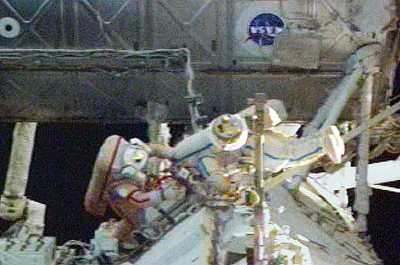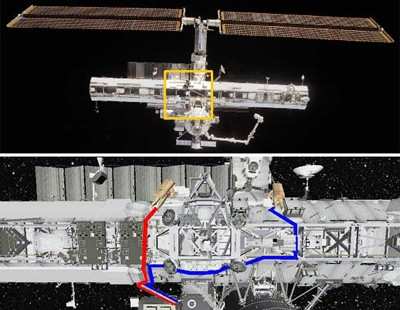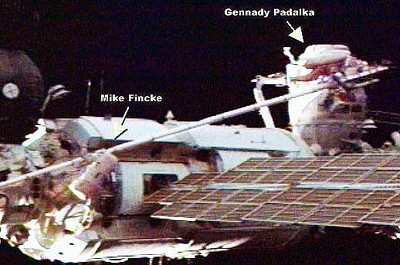ISS Crew Successfully Repairs Gyro Circuit Breaker
International Space Station Commander Gennady Padalka and NASA
ISS Science Officer Mike Fincke successfully changed out a module
containing a faulty circuit breaker Wednesday night, restoring
power to one of the Station's Control Moment Gyros.

CMG 2 was successfully spun up for about a minute, to about 30
rpm, to verify it was working properly before being spun down. That
was done while Padalka and Fincke were still at the worksite, the
S0 center segment of the Station's main truss.
"Gennady and Mike, we have some great news for you," Capcom Rex
Walheim told the crew from Mission Control Houston shortly before 8
p.m. The circuit had been closed and power restored. "The R&R
was successful."
"That's great," Fincke replied. "Congratulations to you guys on
the ground -- you guys put in so many hours to make this spacewalk
possible."
"We've been preparing for this for a month and a half," Padalka
told Mission Control Houston. "Congratulations." Mission Control
Moscow added its congratulations for both spacewalkers.
The repair was completed well ahead of schedule. The
spacewalkers returned to the Pirs Docking Compartment the way they
had come, using the Strela crane attached to Pirs as a pathway.
They were well ahead of their timeline, and completed "get ahead"
tasks -- including installation of flexible handrails and a
contamination monitor on Pirs.
They subsequently entered the airlock and closed the hatch,
ending the spacewalk at 10:59 p.m. EDT. Total time of the spacewalk
was 5 hours, 40 minutes.
Padalka and Fincke floated into space from the Pirs Docking
Compartment's airlock after the hatch opened at 5:19 p.m. EDT,
beginning a second try to replace a Station circuit breaker.
They wore the same Russian Orlan spacesuits they used during
their June 24 spacewalk, cut short after about 14 minutes because
of a balky handle that activates a switch in Fincke's suit. That
caused an unexpected pressure drop in his main oxygen tank.
Restoration of electricity to CMG 2, one of three functional
CMGs, was the purpose of the spacewalk, which began about 20
minutes early. CMG 2 went off-line April 21 when it lost power. The
two gyroscopes that kept working adequately controlled the
Station's attitude, but a third operating CMG provides backup
capability. The fourth CMG failed two years ago, and will be
replaced when Space Shuttle flights resume next year.

The 600-pound gyroscopes, situated in the Z1 Truss just above
the Station's Unity Node, control the attitude, or orientation in
space, of the orbiting laboratory. Flight controllers continue to
test CMG 2 and its electrical supply. It should be spun up to its
operational 6,600 rpm rate by Thursday afternoon.
In their investigation of the June 24 spacewalk, managers found
the balky handle was not fully seated into the closed position
before the spacewalk started. Russian technicians concluded that it
was an isolated event and gave the crew an OK to use the same suits
for Wednesday's spacewalk.
Wednesday's spacewalk preparation procedures were updated to
provide additional verification to ensure the handle was in the
proper position.
This spacewalk followed the same plan crewmembers had set out to
follow last week. That was to have been the first time a spacewalk
was done in Russian spacesuits to replace a US component on the US
segment of the Station.
When the crew was outside the Russian segment of the Station, at
the beginning and end of the Wednesday spacewalk, flight
controllers at Mission Control Moscow spoke to Fincke and Padalka
in Russian. Outside the US segment of the Station, the team in
Houston spoke to them in English.
At the main truss, Padalka and Fincke replaced the Remote Power
Controller Module (RPCM) that houses the faulty circuit breaker.
That done, Fincke and Padalka returned to the Russian crane, and
Russian ground controllers again took over primary support.
Throughout the spacewalk (the second for Fincke and the fourth
for Padalka, who did two previous spacewalks aboard the Mir Space
Station in 1998), flight controllers in Houston and Moscow remained
in constant contact with each other, virtually working side by side
despite the physical distance between them. During previous
spacewalks, a single control center, either in Russia or the United
States, has been the lead for the spacewalk.
This spacewalk plan initially called for use of American
spacesuits and the US Quest Airlock. But the crew could not get the
cooling system of one of the US spacesuits to work.

Using the Russian spacesuits posed some additional challenges.
The spacewalkers used VHF radio antennas on the Russian end of the
Station, and there was concern that the truss structure could
interfere at times with those radio signals. But communications
worked well throughout the spacewalk.
They also had to go about twice as far to get to the worksite as
they would have if they had started from the US airlock. That meant
they had to be outside the Station longer and use the Russian
Strela cargo crane, attached to the Pirs, to reduce their travel
time. Also, the Russian spacesuit gloves are not as supple as those
of the American suits.
If communications had been blocked, Padalka and Fincke might not
have been able to talk to the ground or to each other. Control
teams developed the system of four simple hand signals and had
identified a place near the worksite from which their radios'
signals could reach the antennas.
Mission Control also had a "pager signal" to alert the
spacewalkers. Controllers could simply turn off the light at the
end of Canadarm2, positioned to provide camera views of the repair
work. Neither the pager nor the hand signals were needed.
This was the 54th spacewalk for station assembly and
maintenance.
 ANN's Daily Aero-Linx (04.15.24)
ANN's Daily Aero-Linx (04.15.24) Classic Aero-TV: 'No Other Options' -- The Israeli Air Force's Danny Shapira
Classic Aero-TV: 'No Other Options' -- The Israeli Air Force's Danny Shapira Aero-News: Quote of the Day (04.15.24)
Aero-News: Quote of the Day (04.15.24) Airborne 04.16.24: RV Update, Affordable Flying Expo, Diamond Lil
Airborne 04.16.24: RV Update, Affordable Flying Expo, Diamond Lil ANN's Daily Aero-Term (04.16.24): Chart Supplement US
ANN's Daily Aero-Term (04.16.24): Chart Supplement US





